What Is Dragon's Beard Candy And Why Is It So Difficult To Make?
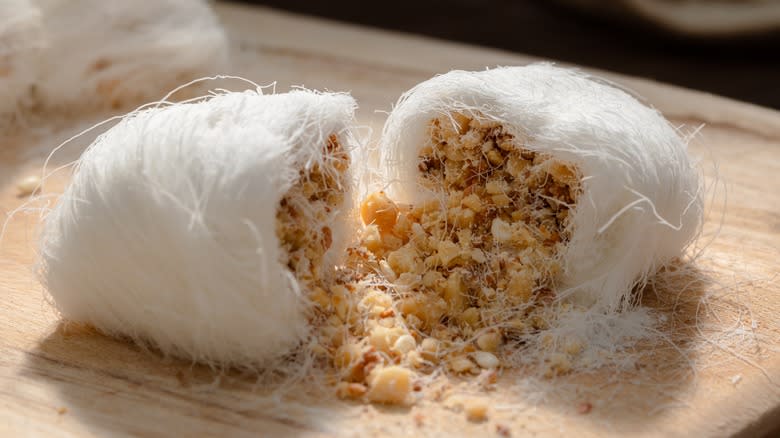
Picture this: delicate strands of sugary perfection, meticulously crafted through a mesmerizing process that has withstood the test of time. Dragon's beard candy is a traditional Chinese confection that is known for its beautiful yet difficult preparation method and unique cotton candy-like appearance. But despite having been around for over 2,000 years, it is still a fairly obscure candy outside of China. Thankfully, the Chinese diaspora has kept this candy-making process relevant and alive by teaching it to new audiences. And now that the social media era is spreading new excitement for this ancient candy-making technique across the globe faster than ever before, dragon's beard candy is finally having another moment in the spotlight.
So, let's dive into exactly why candy makers and epicureans are so excited about this traditional Chinese confection. Below, we cover everything you need to know about dragon's beard candy, including where it came from, how it is made, and why it is so challenging for many candy makers to make. Our first stop is Ancient China.
Read more: 13 Store-Bought Ice Cream Bars Ranked From Worst To Best
What Is The History Of Dragon's Beard Candy?
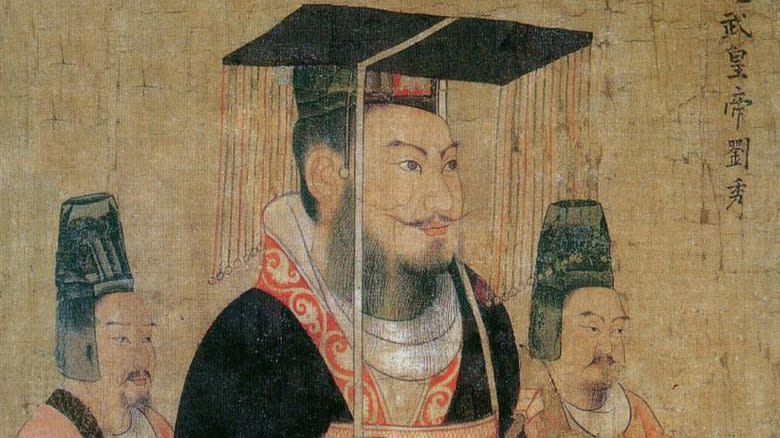
As previously mentioned, dragon's beard candy has been around for a long time. Legends about this confection date back to the Han dynasty, sometime between 202 B.C. and 9 A.D. As one story goes, the name was coined when a Han dynasty emperor got the candy's long, fine threads stuck to his own beard, making it resemble the wispy beard of a dragon (via Atlas Obscura). At first, this treat was made exclusively for Chinese royalty, but it eventually became available to the masses as demand grew and the preparation technique spread.
Dragon's beard candy hit a rough patch during the years of the Chinese Cultural Revolution. During this period, the Red Guard made a widespread effort to eradicate traditional Chinese cultural practices, including making dragon's beard candy (via A Canadian Foodie). The confection returned to China's cultural milieu following the collapse of the Cultural Revolution, albeit less popular than before. In modern-day China, dragon's beard candy is once again a popular confection to be eaten at festivals and other celebratory occasions.
How Is Dragon's Beard Candy Made?
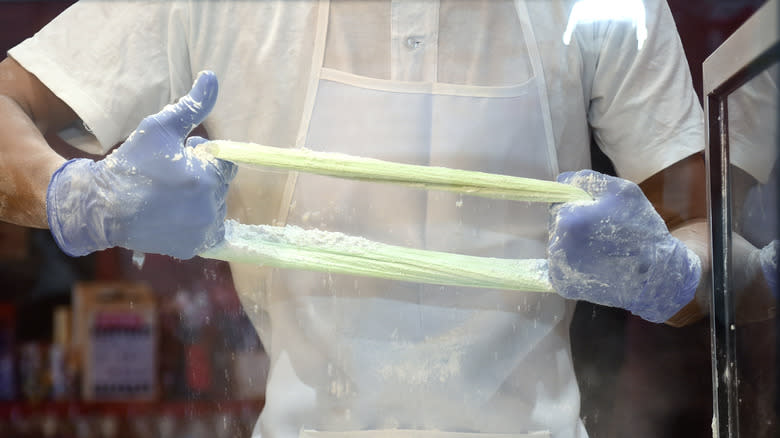
The candy-making process of dragon's beard candy is one of its most fascinating elements, as the production is as fun to watch as it is difficult. For this reason, confectioners that make this treat fresh in front of customers usually draw a crowd. Basically, the candy is pulled thin to a floss-like consistency using a method that is a cross between taffy pulling and hand-rolling traditional Chinese noodles.
The confectioner must first boil sugar syrup to the consistency of butterscotch or taffy. Once it reaches a certain temperature, it is cooled until it can be formed into a donut-shaped piece of candy. Then, while it is still at a pliable temperature, the confectioner must continually stretch the candy and fold it into a figure-eight shape to subdivide the piece into two smaller pieces. The candy is dipped in cornstarch after each fold to prevent the pieces from clumping together. This process is typically repeated over a hundred times to achieve the wispy, hair-thin pieces desired. In a YouTube video from Team Seika, one confectioner pulls over 49,000 strands for a delightful rainbow version of dragon's beard candy. This requires two hundred folds to achieve. Once the process has been completed, the confectioner will usually wrap this wispy candy floss around a filling to make a nugget-shaped treat. However, it can also be eaten by itself like Western-style cotton candy.
Why Is It So Difficult To Make?
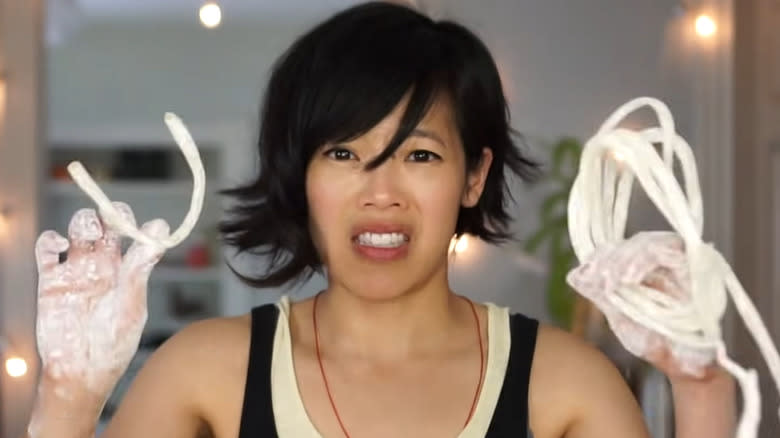
If it wasn't obvious from the instructions above, making dragon's beard candy takes a lot of time, skill, and cleanup. There are potential pitfalls at each step of the process, and a slight error could mean restarting from step one.
The first potential issue comes from boiling the sugar syrup. Sugar syrup requires patience to work with, as it must be constantly monitored as it slowly climbs to the target temperature. You must regularly wipe down the sides of the pot as it boils, or else crystals that form on the side of the pot could fall in and possibly jeopardize the texture of the entire batch. Furthermore, if you let the temperature of the sugar syrup creep too high, then the consistency will become more like peanut brittle or rock candy, and be too hard to shape into fine threads.
However, the real struggle begins during the process of forming the threads. If you pull too hard or the candy becomes too brittle, it will snap, and you will have to start over. This is a common struggle for amateur candy makers, as it takes time to understand the breaking points of candy. Plus, you have to do this hundreds of times, so there is a constant temptation to stretch it to its absolute limit. Finally, having to regularly coat the threads in cornstarch can make a serious mess. When you factor in the cleanup, the whole process could easily take hours.
What Does Dragon's Beard Candy Taste Like?
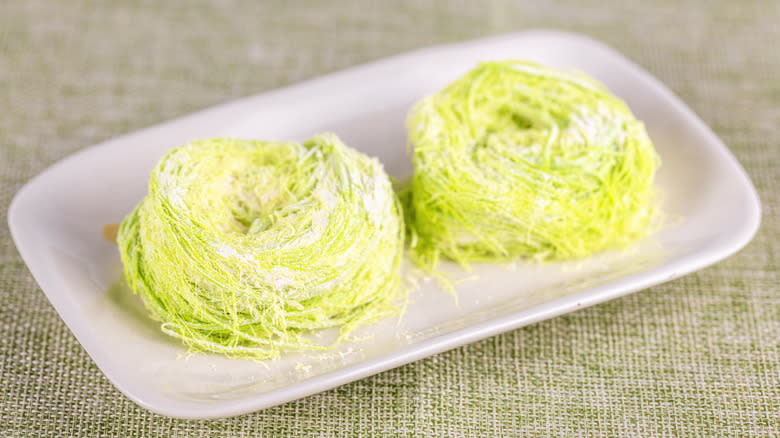
There are two primary elements to the classic dragon's beard candy: the pulled sugar coating and the filling. They combine to make for a confectionery experience unlike any other. The pulled sugar exterior is more of a textural element than a flavor element. The strands of sugar are chewy and slightly sticky, making for a surprisingly dense bite. The mouthfeel is not unlike nougat or taffy. The sugar strands differ in that they quickly melt in your mouth before coating the crunchy center. Since it is traditionally made from unflavored sugar syrup, it usually tastes sweet (but not too sweet). It can, however, be flavored to complement the candy's filling.
The most common fillings for traditional dragon's beard candies are peanuts, sesame seeds, and coconut. These more savory flavors nicely complement the sweet profile of the sugar strands. That said, modern variations of this candy are made with more adventurous flavors. One San Francisco-based confectioner under the name of Dragon Papa Dessert has sold dragon's beard candy with a fairly experimental selection of sweet fillings and flavors. These include Mango, Strawberry, Coffee, and Green Tea. One confectioner on TikTok even concocted a Mexican-inspired watermelon and tajin flavor.
What Are The Differences Between Dragon's Beard Candy And Cotton Candy?
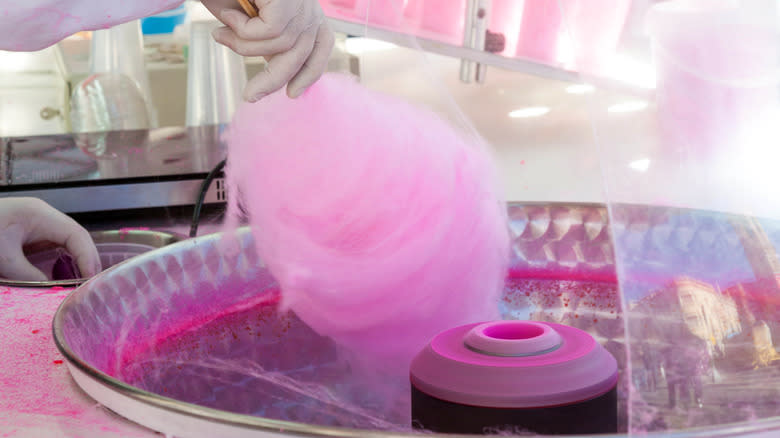
Although dragon's beard candy is also known as Chinese cotton candy, it is not very similar to Western-style cotton candy at all. Outside of their fibrous appearance and names, the two products are actually quite different. In terms of production, the strands of Western cotton candy are made by spinning liquid sugar at high speeds to form cotton-like tufts. Meanwhile, the strands of dragon's beard candy are hand-pulled.
Consequently, the textures of these two treats are also quite different. Cotton candy has a lighter, fluffier texture, and it melts almost instantly when wet. Dragon's beard candy, on the other hand, is more dense and chewy. And while it would eventually dissolve in water, too, it isn't nearly as quick to melt as Western-style cotton candy.
This difference should be immediately apparent because cotton candy is usually spun around a paper cone, while dragon's beard candy is most commonly packaged in bite-sized pieces. However, the textures of these treats are often conflated due to the unfortunate nickname of "Chinese cotton candy."
Where Can You Buy Dragon's Beard Candy?
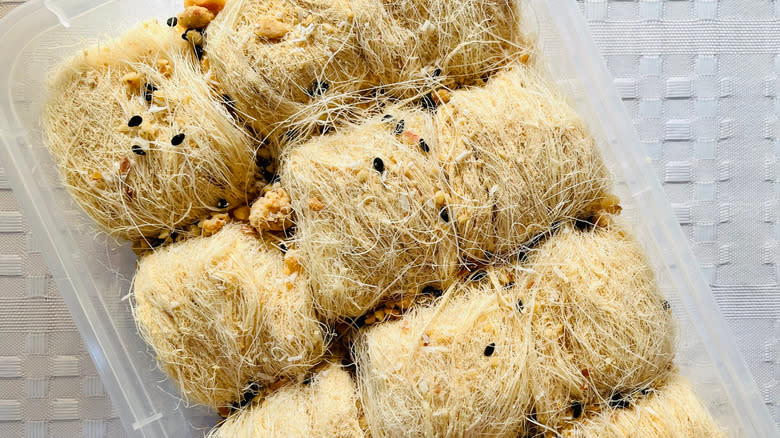
Unfortunately, dragon's beard candy is not widely sold by any major manufacturers in America. Asian grocery stores and Chinatown neighborhoods are both good places to check for dragon's beard candy, but neither is guaranteed to have this traditional delicacy available. Failing that, you can consider buying from an exporter brand online. One of the most popular brands is Yuhin (also called Town Dragon Limited), which is sold on Amazon. They come in Almond, Black Sesame, Ice Crispy, and Popping flavors. You only get four to a package, though, and considering that one package is about $20 at the time of publishing, this is one of the more expensive ways to sample dragon's beard candy.
This obstacle is part of why so many amateur candy makers prefer to make the confection at home. Despite all of the challenges that come with making it from scratch, there is no easier or cheaper way to enjoy the taste of fresh dragon's beard candy (at least when you don't live in China). Whether one buys it or makes it D.I.Y. style, it is something every epicurean should try at least once. That's because there is truly nothing else like it.
Read the original article on Mashed.

 Yahoo Finance
Yahoo Finance 